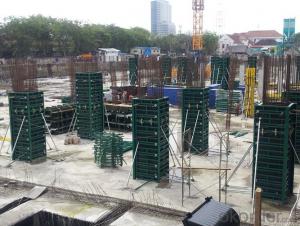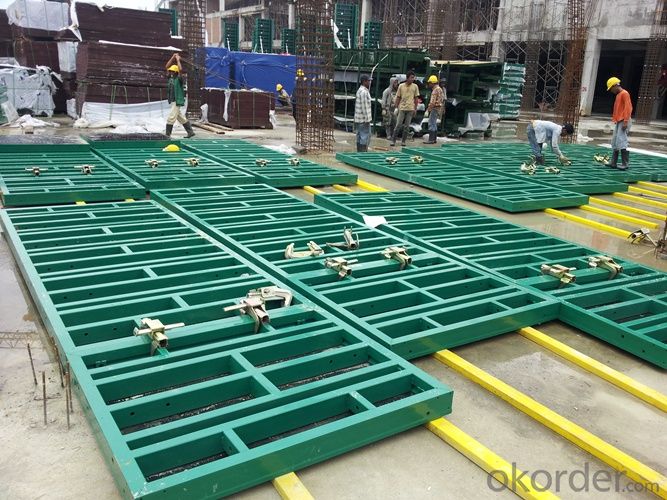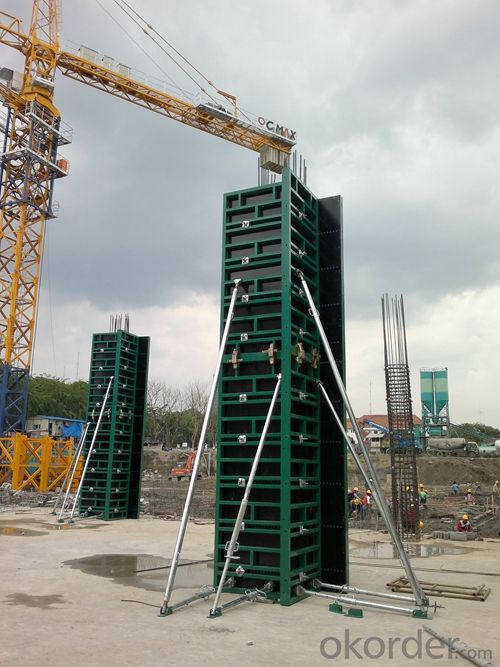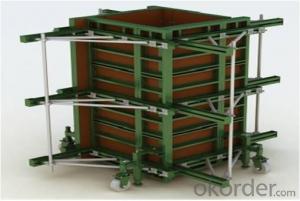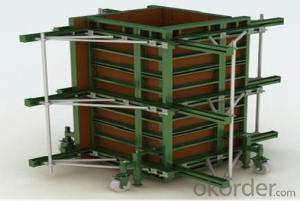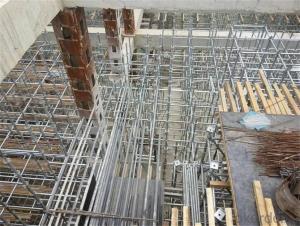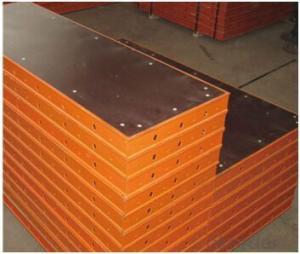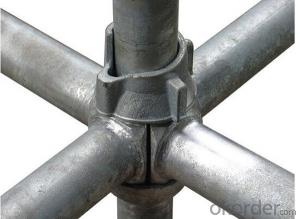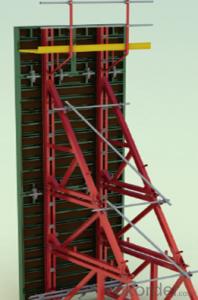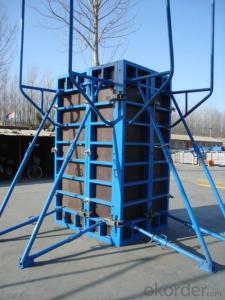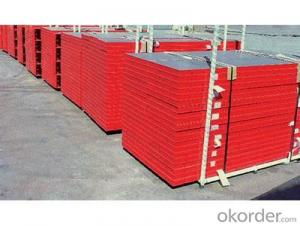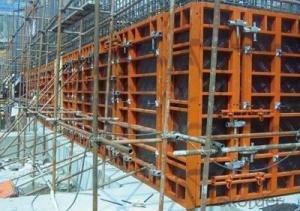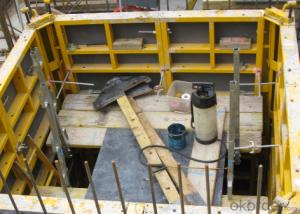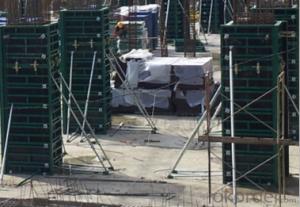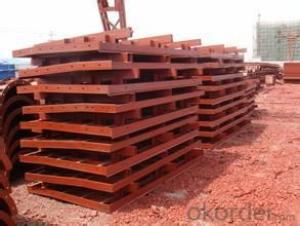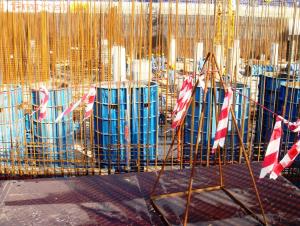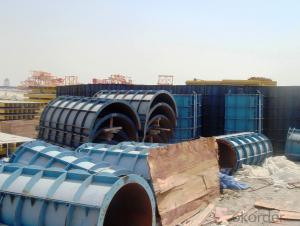120 STEEL FRAME FORMWORK FOR CONSTRUCTIONS
- Loading Port:
- Shanghai
- Payment Terms:
- TT OR LC
- Min Order Qty:
- 1000 m²
- Supply Capability:
- 100000 m²/month
OKorder Service Pledge
OKorder Financial Service
You Might Also Like
1. Structure of 120 Steel Framed Formwork Description
Single-side bracket is a kind of formwork for the concrete pouring of single-side wall. The construction is easy and fast. The components have good standard performance and versatility. The pouring height is adjustable, the maximum height of a single pouring is 8.9m.The formwork is always used in the concrete pouring of basement, subway, Sewage treatment factory and so on. The waterproof of the finished wall is excellent
2. Main Features of 120 Steel Framed Formwork
-easy to assemble
-simple structure.
-and convenient for transportation
-convenient for storage.
3. 120 Steel Framed Formwork Images
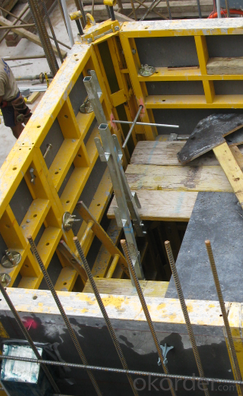
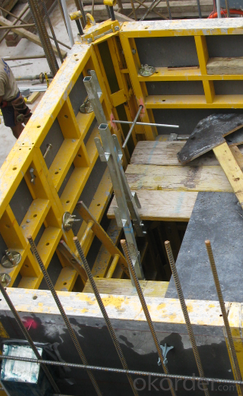
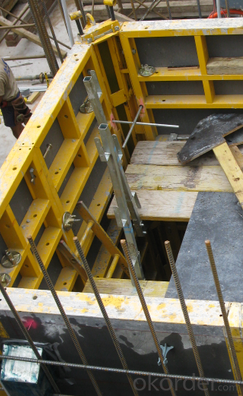
4. Single-side Steel Framed Formwork Specifications
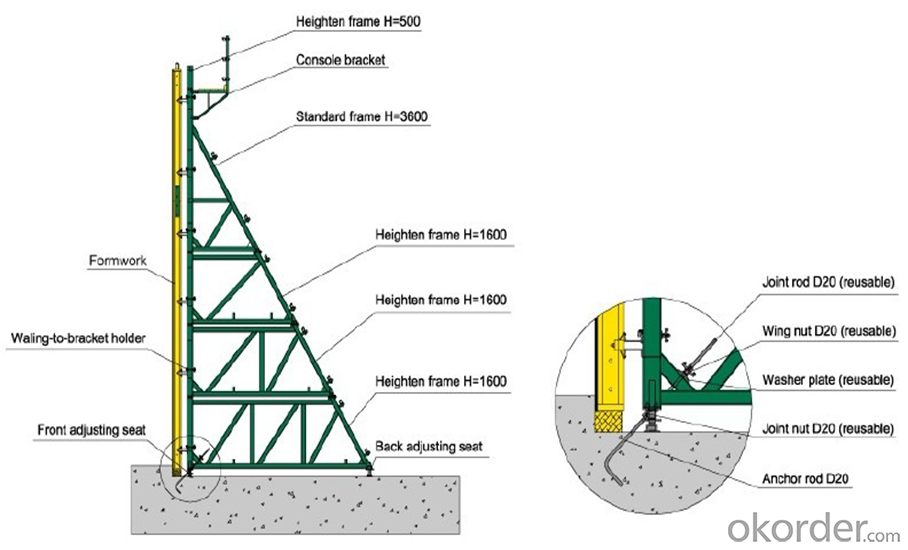
5.FAQ of 120 Steel Framed Formwork
1) What can we do for you?
.We can ensure the quality of the 120 steel framed formwork and avoid extra expenses for customers.
.We can provide you the professional technical team.
.We can provide professional building proposal for your project.
. Please feel free to customize.
2) What promises can be done by us?
. If interested in single side steel framed formwork, please feel free to write us for any QUOTE.
. If need any technical and building assistance, we could provide on-site professional staff for instruction.
. Please DO check goods when courier knocks your door and contact us asap if any issueS.
3) What about of our after-sale service?
. Response will be carried out in 24hours after receiving any complain or request.
. Single side steel framed formwork cost can be refund after order is confirmed.
. If the products are not based on the requirements, there will be the relevant compensations made for you.
4) What about the package and shipping time?
.Packing: wood package and
.Shipping: by sea
Shipping time: Normally small orders, it just1week business days to arrive your hand; When comes to the customs declaration, it may need 2 weeks.
- Q: Can steel frame formwork be used in combination with lightweight concrete mixes?
- Combining steel frame formwork with lightweight concrete mixes is indeed possible. Steel frame formwork is a highly adaptable and long-lasting solution for concrete construction, capable of accommodating a variety of concrete mixes, including lightweight options. Typically, lightweight concrete mixes incorporate lightweight aggregates, such as expanded clay, shale, or pumice, which decrease the overall weight of the concrete without compromising its strength or durability. During the pouring and curing process, steel frame formwork serves as the essential support and structure, effectively securing the lightweight concrete mix in place. This combination enables the creation of structures that are lighter and more efficient, while still meeting the necessary strength and stability requirements. Nonetheless, it is crucial to adhere to the manufacturer's guidelines and specifications for both the steel frame formwork and the lightweight concrete mix to ensure proper compatibility and optimal performance.
- Q: How does steel frame formwork handle the placement of embedded items, such as electrical conduits or plumbing pipes, within the concrete structure?
- A versatile system, steel frame formwork handles the placement of embedded items in concrete structures effectively. The steel frames offer sturdiness and rigidity, allowing for precise positioning and support of electrical conduits or plumbing pipes during the pouring process. One of the main advantages of steel frame formwork lies in its adaptability. The frames can easily be adjusted or modified to accommodate different sizes and types of embedded items. This flexibility guarantees proper positioning and secure fixation of conduits or pipes, minimizing the risk of displacement or damage during construction. Furthermore, the steel frames provide a stable and reliable support system for the embedded items. They are designed to withstand the weight of the concrete and other construction loads, ensuring that the conduits or pipes remain in their intended position without sagging or movement. This is essential for maintaining the integrity and functionality of the electrical or plumbing systems within the structure. Moreover, steel frame formwork enables efficient installation of embedded items. The frames can be easily assembled and disassembled, allowing for quick and accurate placement of conduits or pipes before concrete pouring. This not only saves time and labor costs, but also reduces the risk of errors or rework. Additionally, steel frame formwork ensures a smooth and consistent surface finish for the concrete structure. This guarantees proper encasement and protection of the embedded items, preventing potential damage or corrosion. It also facilitates the subsequent installation of finishes or coatings, as the surface is even and free from any obstructions caused by the embedded items. Overall, steel frame formwork is a reliable and efficient system for handling the placement of embedded items in concrete structures. Its adaptability, stability, and ease of installation make it an ideal choice for ensuring the proper positioning and support of electrical conduits or plumbing pipes, resulting in a structurally sound and functional final product.
- Q: Can steel frame formwork be easily transported to different construction sites?
- Indeed, steel frame formwork possesses the convenience of effortless transportation to various construction sites. Renowned for its robustness and longevity, steel emerges as an impeccable substance for formwork systems. Adhering to a modular and lightweight design, steel frame formwork facilitates simple assembly and disassembly. Its structural integrity remains uncompromised during transportation via trucks or containers to diverse construction sites. Furthermore, the adaptability of steel frame formwork permits convenient adjustments to fit varying shapes and sizes of structures, rendering it a versatile preference for myriad construction ventures.
- Q: How does steel frame formwork compare to plastic formwork?
- The specific requirements of the construction project determine whether steel frame formwork or plastic formwork is the better choice. Steel frame formwork is known for its durability and strength, making it suitable for projects requiring repeated use. It can handle heavy loads, is reusable, and can be easily customized. It also provides stability and support for precise concrete placement. On the other hand, plastic formwork has its own advantages. It is lightweight and easy to handle, making it ideal for projects that need frequent transportation and assembly. It resists corrosion, reducing maintenance costs over time. Additionally, it offers good insulation properties. However, plastic formwork may not be as effective as steel frame formwork in handling heavy loads or lasting as long. It may also have limitations in terms of customization and adjustability for complex shapes. In conclusion, the choice between steel frame formwork and plastic formwork depends on factors such as project requirements, budget, and specific conditions. Steel frame formwork is reliable and versatile, while plastic formwork is lightweight and cost-effective. It is important to consider project needs and consult with construction professionals to determine the most suitable formwork option.
- Q: What are the common safety training requirements for using steel frame formwork systems?
- The common safety training requirements for using steel frame formwork systems include: 1. Proper understanding of the equipment: Users should be trained on the correct assembly, disassembly, and operation of the steel frame formwork systems. This includes knowing the different components, their purpose, and how they fit together. 2. Personal protective equipment (PPE): Trainees should be educated on the importance of wearing appropriate PPE such as hard hats, safety goggles, gloves, and steel-toed boots. They should understand how to properly use, maintain, and inspect their PPE to ensure its effectiveness. 3. Fall protection: Falling from heights is a significant risk when working with steel frame formwork systems. Safety training should cover the use of fall protection equipment such as harnesses, lanyards, and anchor points. Users should be trained on how to properly set up and use these systems to prevent falls. 4. Load capacity and weight limits: Steel frame formwork systems have specific load capacity and weight limits that must be adhered to. Training should focus on understanding these limits and how to calculate and distribute loads safely. Users should be aware of the risks associated with overloading and how it can compromise the stability and safety of the structure. 5. Proper handling and storage: Training should cover the correct methods for handling and storing steel frame formwork components. This includes techniques for lifting, moving, and securing the equipment to prevent accidents and damage. Users should also be educated on how to store the components to maintain their structural integrity and prevent rust or deterioration. 6. Hazard identification and mitigation: Safety training should emphasize the importance of identifying potential hazards on the construction site and implementing measures to mitigate them. Users should be trained to recognize and address hazards such as uneven ground, overhead obstructions, electrical hazards, and inclement weather conditions. 7. Emergency procedures: Trainees should be familiarized with emergency procedures, including evacuation plans, first aid, and reporting protocols. They should understand how to respond to accidents, injuries, or equipment failures and know how to communicate effectively in case of an emergency. Overall, safety training for using steel frame formwork systems is crucial to ensure the well-being of workers and the successful completion of construction projects. It is essential to provide comprehensive training that covers all potential risks and equips users with the knowledge and skills to work safely and efficiently with these systems.
- Q: How does steel frame formwork ensure proper ventilation during concrete curing?
- Proper ventilation during concrete curing cannot be directly ensured by steel frame formwork. Nevertheless, it can indirectly aid ventilation by allowing ample space between the formwork panels and the concrete surface. This space permits air circulation and facilitates the evaporation of excess moisture during the curing process. Furthermore, steel frame formwork may include strategically positioned holes or slots to amplify airflow and foster appropriate ventilation. However, it is crucial to acknowledge that the primary responsibility for guaranteeing proper ventilation during concrete curing rests with the overall construction design, which encompasses the implementation of appropriate curing techniques and the provision of sufficient ventilation openings in the formwork system.
- Q: How does steel frame formwork handle the placement of precast concrete elements within the concrete structure?
- A highly efficient and versatile system specifically designed for handling the placement of precast concrete elements within a concrete structure is steel frame formwork. This system consists of steel frames that are assembled to create a temporary mold or structure for shaping the concrete during construction. When it comes to placing precast concrete elements, the steel frame formwork offers several advantages. Firstly, the steel frames can be easily adjusted and aligned to match the size and shape of the precast elements, ensuring a precise fit. This is crucial as it helps minimize any gaps or irregularities between the precast elements and the surrounding concrete structure. Additionally, the steel frame formwork provides the necessary support and stability for the precast elements. The strong and rigid steel frames can withstand the weight and pressure exerted by the precast elements, ensuring they remain in position during the pouring and curing of the concrete. Furthermore, the steel frame formwork allows for efficient installation and removal of the precast elements. The frames can be easily assembled and disassembled, enabling quick and smooth installation of the precast elements. This saves time and labor costs, making the construction process more efficient. In conclusion, steel frame formwork is a reliable and effective system for handling the placement of precast concrete elements within a concrete structure. Its flexibility, stability, and ease of use make it an ideal choice for ensuring a seamless integration of precast elements into the overall construction process.
- Q: How is the stability of steel frame formwork ensured during the construction process?
- The stability of steel frame formwork is ensured during the construction process through several measures. Firstly, the steel frame formwork is designed and engineered to withstand the loads and pressures exerted during the concrete pouring and curing process. The frame is typically made of high-quality steel that has been tested for its strength and durability. To further enhance stability, bracing systems are installed at regular intervals along the formwork. These braces provide additional support and prevent any deformation or collapse of the formwork. The bracing systems are carefully designed and installed to withstand the lateral forces and ensure the formwork remains stable throughout the construction process. In addition, proper installation and anchoring of the steel frame formwork are crucial for its stability. The formwork is securely fixed to the ground or supporting structure using various anchoring systems, such as ground anchors or wall ties. These anchoring systems prevent any movement or displacement of the formwork, ensuring its stability. Regular inspections and maintenance are also conducted during the construction process to ensure the stability of the steel frame formwork. Any signs of damage, deformation, or wear are promptly addressed and repaired to prevent any compromise in stability. Moreover, adherence to safety regulations and guidelines is essential in ensuring the stability of the steel frame formwork. Construction workers are trained to follow proper procedures and protocols while handling and working with the formwork. This includes ensuring proper placement and alignment, avoiding overloading, and maintaining a safe working environment. Overall, the stability of steel frame formwork is ensured through careful design, proper installation, regular inspections, and adherence to safety guidelines. These measures collectively contribute to the safe and efficient construction process while minimizing the risk of accidents or structural failures.
- Q: How does steel frame formwork handle the placement of MEP (mechanical, electrical, plumbing) systems within the concrete structure?
- The versatility and efficiency of steel frame formwork make it an excellent choice for accommodating MEP systems in concrete structures. The sturdy steel frames provide reliable support, allowing for seamless integration of MEP components. One of the main advantages of steel frame formwork is its adaptability. The frames can be easily customized to meet the specific requirements of MEP systems, including creating openings for pipes, conduits, and ducts. This flexibility ensures that MEP systems can be incorporated efficiently without compromising the integrity of the concrete structure. In addition, steel frame formwork offers exceptional load-bearing capabilities, which is crucial considering the weight and potential vibrations associated with MEP systems. The strong and durable steel frames can withstand the weight and movement of MEP components, providing a stable platform for their installation. Furthermore, steel frame formwork allows for precise placement of MEP systems. The frames can be easily aligned and leveled, ensuring accurate installation. This is especially important in complex MEP installations to avoid clashes between different systems. Moreover, steel frame formwork simplifies the installation and maintenance of MEP systems. The frames provide easy access to the components, facilitating convenient installation, inspection, and maintenance. This accessibility allows for efficient repairs and modifications, reducing downtime and minimizing disruptions to the concrete structure. In conclusion, steel frame formwork is an efficient and effective system for integrating MEP systems into concrete structures. Its adaptability, load-bearing capabilities, precision, and accessibility make it an ideal choice for seamless integration of MEP components.
- Q: How does steel frame formwork prevent concrete shrinkage or cracking?
- Steel frame formwork prevents concrete shrinkage or cracking by providing a strong and rigid support system that holds the concrete in place during the curing process. This helps to prevent the concrete from moving or shifting, allowing it to dry evenly and reducing the chances of shrinkage or cracking. Additionally, the steel frame formwork helps to distribute the weight of the concrete evenly, minimizing the stress on any particular area and further reducing the risk of shrinkage or cracking.
Send your message to us
120 STEEL FRAME FORMWORK FOR CONSTRUCTIONS
- Loading Port:
- Shanghai
- Payment Terms:
- TT OR LC
- Min Order Qty:
- 1000 m²
- Supply Capability:
- 100000 m²/month
OKorder Service Pledge
OKorder Financial Service
Similar products
Hot products
Hot Searches
Related keywords
